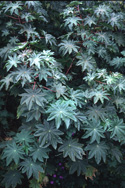
Photo © Steven Foster
Introduction
Castor, also known as castor bean, is an evergreen shrub that can grow to the size of a small tree in the tropics.1 It is native to western Asia and northeast Africa and has been cultivated for more than 6000 years. The plant produces large palm shaped leaves, yellow-green flowers with a red stigma (female reproductive part), followed by red-brown seed capsules containing gray-brown seeds. Castor oil is expressed from the seed.1 History and Cultural Significance
All parts of the castor plant are toxic if eaten, which kept many cultures from utilizing the plant. The Ancient Egyptians were an exception and used castor oil in lamps, and would drink castor oil in beer three times a month to purge their bodies.2 The Greeks and Romans mainly used the oil for external application. Not until the eighteenth century was castor oil used internally again as a laxative.2 Modern cultures have discovered that the castor oil expressed from the seeds of the plant is not toxic. The extraction process yields oil that is free of the toxin, ricin, but includes ricinoleic acid,3 which is responsible for the laxative action of the oil.2 Castor oil is used to clear the bowels before X-ray examination and in the treatment of food poisoning.3 The oil has a very unpleasant taste and is often hidden by administering it in combination with peppermint, cinnamon, lemon oil, coffee, or tea.4 The oil has emollient (skin-softening) properties2,3 and can be found in cosmetics such as creams, lotions, lipstick, ointments, soaps, and hair products.3 Castor oil is employed by the food industry as a flavor component (nutty or buttery) in baked goods, candy, frozen dairy desserts, nonalcoholic beverages, and meat products.3 It is also commonly found in candles, crayons, varnishes, lubricants, and leather preservatives,1 as well as ophthalmic (eye) preparations.1,3 Castor oil has very few culinary uses. When food is scarce in Nigeria, natives will boil the castor seeds for an hour and then ferment for two days to render the seeds edible. After fermentation, the seeds are pounded into a paste for eating.5 The seeds have also been used in making jewelry.1 Modern Research
One study indicates that castor oil eye drops may be useful in the treatment of a condition that results in chronic dry eyes.6 Future Outlook
As of October 2002, China, India, and Brazil accounted for 90% of the acreage and production of castor beans, which was close to 1,228,000 tons in 2000.7 Castor is also grown in Costa Rica, Ecuador, Ethiopia, Mexico, Pakistan, Paraguay, the Philippines, Romania, Sudan, Tanzania, and the former USSR. Optimal growing conditions for castor include high temperatures and low humidity and good weed management that may require chemical treatment. Diseases do little damage, but many insect species can damage castor.7 Since castor is grown in so many locales and is used in so many industrial applications, there is currently no concern regarding the production of an adequate supply of castor oil. References
1 Bown D. The Herb Society of America New Encyclopedia of Herbs and Their Uses. London: Dorling Kindersley Ltd; 2001. 2 Onstad D. Whole Foods Companion. White River Junction, VT: Chelsea Green Publishing Co.; 1996. 3 Leung AY, Foster S. Encyclopedia of Common Natural Ingredients Used in Foods, Drugs, and Cosmetics. New York: John Wiley and Sons; 1996. 4 Grieve M. A Modern Herbal. New York: Dover Publications; 1971. 5 Nayudamma Y, Seschachar B, Mithal R, Verma S, Balasundaram M, Kapur A, et al, editors. The Wealth of India: Raw Materials. Volume IX-Rh-So. New Delhi: Publications & Information Directorate (CSIR); 1988. 6 Goto E, Shimazaki J, Monden Y, Takano Y, YagiY, Shimmura S, et al. Low-concentration homogenized castor oil eye drops for noninflamed obstructive meibomian gland dysfunction. Ophthalmology. 2002:109(11);2030-2035. 7 Castor. Available at: http://www.ienica.net/crops/castor.htm. Accessed March 18, 2005.
|